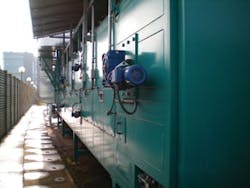Siemens commissions on-site mobile treatment equipment, services for produced water at western U.S. site
WARRENDALE, PA, July 27, 2009 -- Siemens Water Technologies has commissioned a produced water treatment system for a major oil company's site in Western U.S. The system, consisting of on-site mobile equipment and services, recycles flowback water through the treatment process to provide a source of "frac" water for reuse. Sized for 6,000 barrels per day (bpd), the mobile system consists of a flotation unit, media filtration and cartridge filtration. The heart of the system is the Veirsep system; a horizontal flotation system that incorporates several unique technologies to separate oil, grease and suspended solids from the flowback stream. The system also supports the customer's green objectives by conserving fresh water and avoiding greenhouse gas emissions.
This flowback water treatment application is unique in that it leverages years of offshore produced water experience to meet onshore produced water objectives. The Veirsep system has been used in offshore applications to reduce oil and grease levels to meet discharge quality requirements for over 15 years. Siemens has modified the equipment for onshore applications to offer a finer degree of oily water separation that makes the water suitable for hydraulic fracturing or "fracing" (a method used to create fractures that extend from a borehole into rock formations).
The Veirsep system consists of an inlet centrifugal coalescing device (Spiralsep system), influent and effluent surge compartments, four flotation chambers, an oil collection weir system, Brise Dissolved Gas Flotation (DGF) pumps for recycling fluid and generating varying micron size air/gas bubbles, and all required control and operational accessories. The system is the latest addition to Siemens' modular Produced Water Services. These services are designed based on the water supply and specific needs of the customer and supported through Siemens' application engineering and treatment expertise. Siemens' Produced Water Services offer treatment for frac water supply, direct discharge and brine management.
This region of the country is challenged with a limited supply of fresh water and a local objective to reduce truck transport and associated greenhouse gases. The oil company is saving money by using Siemens' on-site mobile water treatment equipment and services to process flowback to a reuse standard, rather than hauling the water to an injection well for disposal. The process is eco-friendly in that it conserves fresh water for municipal and agricultural use. This innovative process also reduces emissions through reduced truck traffic. System capacity is 6,000 bpd and recovers over 90% of the fluids for reuse. Each water truck holds just over 100 barrels of water and travels 100 miles round trip to the disposal site. At full capacity, each day the Siemens process will eliminate 54 roundtrips and 5,400 truck miles from the local highways. Given truck mileage performance of 7 miles per gallon, with every gallon of diesel producing 22 pounds of CO2 emissions, the Siemens process avoids adding an additional 17,000 pounds of CO2 into the air each day, equivalent to over 3,000 tons per year.
The Veirsep system incorporates several unique technologies to separate oil and various other contaminants from the flowback stream.
With the business activities of Siemens VAI Metals Technologies, (Linz, Austria), Siemens Water Technologies (Warrendale, Pa., U.S.A.), and Industrial Technologies, (Erlangen, Germany), the Siemens Industry Solutions Division (Erlangen, Germany) is one of the world's leading solution and service providers for industrial and infrastructure facilities.
###

